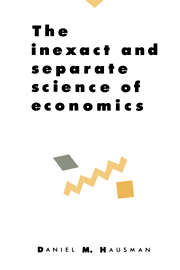Book contents
- Frontmatter
- Contents
- List of figures
- Dedication
- Introduction
- Part I Introduction, structure, and strategy
- 1 Rationality and utility theory
- 2 Demand and consumer choice
- 3 The theory of the firm and general equilibrium
- 4 Equilibrium theory and economic welfare
- 5 Models and theories in economics
- 6 The structure and strategy of economics
- 7 Overlapping generations: a case study
- Part II Theory assessment
- Part III Conclusion
- Appendix: An introduction to philosophy of science
- Bibliography
- Index
6 - The structure and strategy of economics
Published online by Cambridge University Press: 04 August 2010
- Frontmatter
- Contents
- List of figures
- Dedication
- Introduction
- Part I Introduction, structure, and strategy
- 1 Rationality and utility theory
- 2 Demand and consumer choice
- 3 The theory of the firm and general equilibrium
- 4 Equilibrium theory and economic welfare
- 5 Models and theories in economics
- 6 The structure and strategy of economics
- 7 Overlapping generations: a case study
- Part II Theory assessment
- Part III Conclusion
- Appendix: An introduction to philosophy of science
- Bibliography
- Index
Summary
Over the last two decades philosophers interested in scientific theory have been concerned not only to improve the logical empiricist's view of scientific theories, but to supplement it with accounts of the broader structures which shape individual theories and are in turn shaped by particular theoretical achievements. The best known of these accounts have been presented by Thomas Kuhn and Imre Lakatos. Before offering my own abstract characterization of the structure and strategy of economic theorizing, let me consider whether their accounts can help with this task.
Disciplinary matrices
Although few philosophers of science are satisfied with his particular formulations, Thomas Kuhn (1970) deserves credit for first devoting sustained attention to such “metatheoretical structures,” which he initially called “paradigms,” then “disciplinary matrices” (1970, Postscript, 1974). Disciplinary matrices are the constellation of beliefs, presumptions, heuristics, and values that tie together the theoretical efforts of practitioners of some discipline. When Kuhn speaks of a “discipline” or a “community,” he has in mind specific theoretical enterprises which involve perhaps a few dozen scientists. But I shall not be stretching his remarks in an unusual way if I take them as applying to microeconomics as a whole.
In Kuhn's view, disciplinary matrices consist of four main components: (1) “symbolic generalizations,” (2) metaphysical and heuristic commitments, (3) values, and (4) “exemplars.” Symbolic generalizations resemble fundamental laws. They are not merely empirical generalizations, but fundamental laws that often serve to define the terms they employ.
- Type
- Chapter
- Information
- The Inexact and Separate Science of Economics , pp. 83 - 101Publisher: Cambridge University PressPrint publication year: 1992



